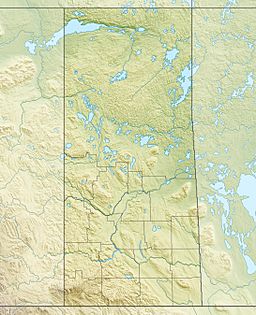Moosonees Lake facts for kids
Quick facts for kids Moosonees Lake |
|
|---|---|
| Location | Saskatchewan |
| Coordinates | 59°02′01″N 104°08′02″W / 59.03361°N 104.13389°W |
| Basin countries | Canada |
| Surface area | 9.75 square kilometres (3.76 sq mi) |
| Shore length1 | 23.4 kilometres (14.5 mi) |
| Surface elevation | 353 metres (1,158 ft) |
| 1 Shore length is not a well-defined measure. | |
Moosonees Lake is a cool, faraway lake located in the northern part of Saskatchewan, Canada. It sits about 3 kilometers (2 miles) north of the Fond du Lac River. A stream, which is about 17 kilometers (11 miles) long, flows out of the lake towards the northwest, linking it to the river.
Contents
About Moosonees Lake
Moosonees Lake is a beautiful natural feature in the Canadian wilderness. It's known for its remote location and peaceful surroundings. The lake is a great example of the many bodies of water found in Canada's vast northern regions.
Lake Size and Shape
The surface of Moosonees Lake is 353 meters (1,158 feet) above sea level. This means it's quite high up! The lake covers an area of about 9.75 square kilometers (3.76 square miles). To give you an idea of its size, it stretches about 3.5 kilometers (2.2 miles) from north to south. It's even wider from east to west, measuring about 5.9 kilometers (3.7 miles) across.
Climate and Nature Around the Lake
The area around Moosonees Lake is part of the subarctic climate zone. This means the weather can be very cold for much of the year. Winters are long and chilly, while summers are short and cool.
Subarctic Environment
In a subarctic climate, you'll find specific types of plants. The trees around Moosonees Lake are mostly sparse. This means they are spread out and not very dense. They are often low-growing subarctic woods. These trees are tough and can survive the cold temperatures and harsh conditions of the region.
Wildlife in the Region
While the text doesn't mention specific animals, remote lakes in subarctic regions are often home to various wildlife. You might find animals like moose, caribou, bears, and many types of birds. These creatures have adapted to live in this unique environment.


